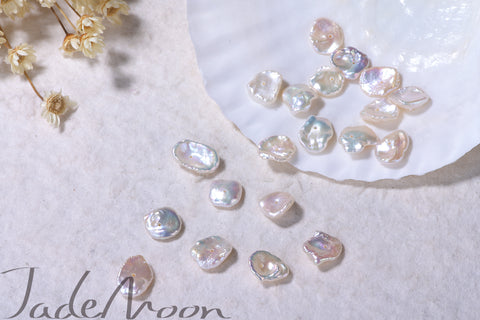Keshi pearls are small non-nucleated pearls that come in non-standard shapes and sizes. They are the gorgeous by-products during pearl culturing processes. Keshi pearls are produced unintentionally when the mollusk expels the bead but continues to develop the pearl, causing nacre cannot form around the bead. Therefore, Keshi pearls are composed entirely of nacre, with no nucleus inside.
Keshi are the rarest baroque pearls and happen when the mollusk rejects the seed but continues to develop the pearl, so they do not have a center particle. They are elongated and extraordinarily lustrous.
 The word Keshi comes from keshinomi, meaning “poppy seed” in Japanese. They are solid-nacre, usually small in size. Nowadays, Keshis have become highly collectible pearls in their own right due to their unique shapes and high rate of iridescence.
The word Keshi comes from keshinomi, meaning “poppy seed” in Japanese. They are solid-nacre, usually small in size. Nowadays, Keshis have become highly collectible pearls in their own right due to their unique shapes and high rate of iridescence.Keshi pearls are known for their distinct characteristics:
1. Luster: Keshi pearls have a remarkable luster due to their all-nacre composition, which gives them a vibrant and reflective surface.
2. Shape: They come in irregular shapes, often resembling baroque pearls.Their unique and non-uniform shapes add to their charm and individuality.
3. Size: Keshi pearls can vary in size, ranging from very small to larger sizes, depending on the type of mollusk and the specific culturing process.
4. Color: They come in a wide range of colors, including white, cream, silver, and various shades of pastels. The color is determined by the type of oyster and the water conditions.
5. Surface: The surface of Keshi pearls can be relatively smooth but may also have minor surface irregularities, which are natural for pearls formed without a nucleus.
6. Value: Keshi pearls are often highly valued by pearl enthusiasts and collectors due to their rarity, unique appearance, and the quality of nacre. Their value can be comparable to or even exceed that of traditional cultured pearls.
7. Organic Origin: Like other pearls, Keshi pearls are organic gems formed within the bodies of mollusks. Their formation occurs when the oyster expels the nucleus introduced during the culturing process, allowing the nacre to continue growing.

